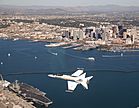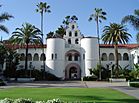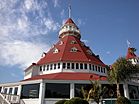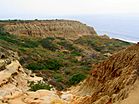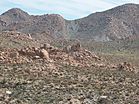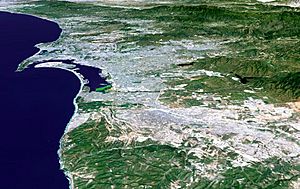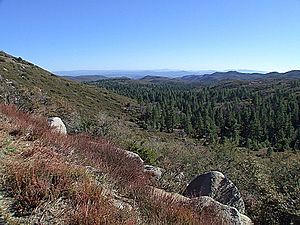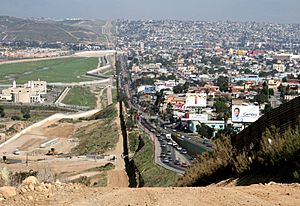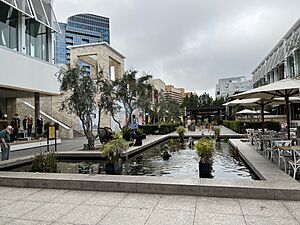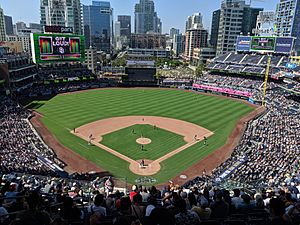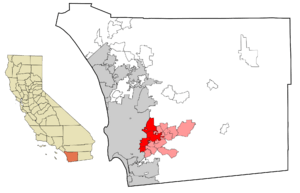San Diego County, California facts for kids
Quick facts for kids
San Diego County
|
|||||
|---|---|---|---|---|---|
| County of San Diego | |||||
|
From top down and left to right: F/A-18 Hornet flying over San Diego, Mission San Diego de Alcalá, San Diego State University's Hepner Hall, Hotel del Coronado, Torrey Pines State Natural Reserve, Jacumba Mountains
|
|||||
|
|||||
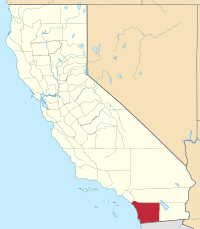
Location in California
|
|||||
| Country | |||||
| State | |||||
| Formed | February 18, 1850 | ||||
| Named for | Saint Didacus of Alcalá | ||||
| County seat | San Diego | ||||
| Largest city | San Diego | ||||
| Government | |||||
| • Type | Council–CEO | ||||
| • Body | Board of Supervisors | ||||
| Area | |||||
| • Total | 4,260.9 sq mi (11,036 km2) | ||||
| • Land | 3,942 sq mi (10,210 km2) | ||||
| • Water | 319 sq mi (830 km2) | ||||
| Highest elevation | 6,533 ft (1,991 m) | ||||
| Population | |||||
| • Total | 3,298,634 | ||||
| • Estimate
(2023)
|
3,269,973 |
||||
| • Density | 774.164/sq mi (298.906/km2) | ||||
| GDP | |||||
| • Total | 7.341 billion (2022) | ||||
| Time zone | UTC–8 (Pacific Time Zone) | ||||
| • Summer (DST) | UTC–7 (Pacific Daylight Time) | ||||
| Area codes | 760/442 and 619/858 | ||||
| FIPS code | 06-073 | ||||
| Congressional districts | 48th, 49th, 50th, 51st, 52nd | ||||
San Diego County (![]() i/ˌsæn diˈeɪɡoʊ/), officially the County of San Diego, is a county in the southwest corner of the U.S. state of California, north to its border with Mexico. As of the 2020 census, the population was 3,298,634; it is the second-most populous county in California and the fifth-most populous in the United States. Its county seat is San Diego, the second-most populous city in California and the eighth-most populous in the United States. It is the southwesternmost county in the 48 contiguous United States, and is a border county. It is home to 18 Indian reservations, the most of any county in the United States. There are 16 military installations of the Navy, Marine Corps, and Coast Guard in the county.
i/ˌsæn diˈeɪɡoʊ/), officially the County of San Diego, is a county in the southwest corner of the U.S. state of California, north to its border with Mexico. As of the 2020 census, the population was 3,298,634; it is the second-most populous county in California and the fifth-most populous in the United States. Its county seat is San Diego, the second-most populous city in California and the eighth-most populous in the United States. It is the southwesternmost county in the 48 contiguous United States, and is a border county. It is home to 18 Indian reservations, the most of any county in the United States. There are 16 military installations of the Navy, Marine Corps, and Coast Guard in the county.
San Diego County comprises the San Diego–Chula Vista–Carlsbad, CA Metropolitan Statistical Area, which is the 17th most populous metropolitan statistical area and the 18th most populous primary statistical area in the United States. San Diego County is also part of the San Diego–Tijuana region, the largest metropolitan area shared between the United States and Mexico. From north to south, San Diego County extends from the southern borders of Orange and Riverside counties to the Mexico–U.S. border and the municipalities of Tijuana and Tecate in Baja California. From west to east, San Diego County stretches from the Pacific Ocean to its boundary with Imperial County, which separated from it in 1907.
San Diego County has more than 70 miles (113 km) of coastline. This forms the most densely populated region of the county, which has a mild Mediterranean to semiarid climate and extensive chaparral vegetation, similar to the rest of the western portion of Southern California. Precipitation and temperature extremes increase to the east, with mountains that receive frost and snow in the winter. These lushly forested mountains receive more rainfall than the average in Southern California, while the desert region of the county lies in a rain shadow to the east, which extends into the Desert Southwest region of North America.
Contents
History
The area which is now San Diego County has been inhabited for more than 10,000 years by Kumeyaay (also called Diegueño), Luiseño, Cupeño and Cahuilla Indians.
In 1542, the Portuguese-born explorer Juan Rodríguez Cabrillo, sailing for Spain, claimed San Diego Bay for the Spanish Empire, and he named the site San Miguel. In November 1602, Sebastián Vizcaíno surveyed the harbor and what are now Mission Bay and Point Loma and named the area for Saint Didacus, a Spaniard more commonly known as San Diego. European settlement in what is now San Diego County began with the founding of the San Diego Presidio and Mission San Diego de Alcalá by Spanish soldiers and clerics in 1769. This county was part of Alta California under the Viceroyalty of New Spain until the Mexican declaration of independence. From 1821 through 1848 this area was part of Mexico.
San Diego County became part of the United States as a result of the Treaty of Guadalupe Hidalgo in 1848, ending the U.S.-Mexican War. This treaty designated the new border as terminating at a point on the Pacific Ocean coast which would result in the border passing one Spanish league south of the southernmost portion of San Diego Bay, thus ensuring that the United States received all of this natural harbor.
San Diego County was one of the original counties of California, and it was created at the time of California statehood in 1850.
At the time of its establishment in 1850, San Diego County was relatively large, and included all of southernmost California which was south and east of Los Angeles County. As such it included areas of what are now Inyo County and San Bernardino County, as well as all of what is now Riverside County and Imperial County.
During the later part of the 19th century, there were numerous changes in the boundaries of San Diego County, when various areas became separated for the counties mentioned above. The most recent changes were the establishments of Riverside County in 1893 and Imperial County in 1907. Imperial County was also the last county to be established in California, and after this division, San Diego no longer extended from the Pacific Ocean to the Colorado River, and it no longer covered the entire border between California and Mexico.
Geography
According to the U.S. Census Bureau, the county has an area of 4,526 square miles (11,720 km2), of which 4,207 square miles (10,900 km2) is land and 319 square miles (830 km2) (7.0%) is water. The county is larger in area than the combined states of Rhode Island and Delaware.
San Diego County has a varied topography. On its western side is 70 miles (110 km) of coastline. Most of San Diego between the coast and the Laguna Mountains consists of hills, mesas, and small canyons. Snow-capped (in winter) mountains rise to the northeast, with the Sonoran Desert to the far east. Cleveland National Forest is spread across the central portion of the county, while the Anza-Borrego Desert State Park occupies most of the northeast.
Although the county's western third is primarily urban, the mountains and deserts in the eastern two-thirds are primarily of undeveloped backcountry. Most of these backcountry areas are home to a native plant community known as chaparral. San Diego County contains more than a million acres (4,000 km²) of chaparral, twice as much as any other California county.
North San Diego County is known as North County; the exact geographic definitions of "North County" vary, but it includes the northern suburbs and sometimes certain northern neighborhoods of the City of San Diego.
The eastern suburbs are collectively known as East County, though most still lie in the western third of the county. The southern suburbs and southern detached portion of the city of San Diego, extending to the Mexican border, are collectively referred to as South Bay.
Periodically the area has been subject to wildfires that force thousands to evacuate. The most recent are the May 2014 San Diego County wildfires; before them was the Witch Creek Fire in 2007 and the Cedar Fire in 2003. California defines a fire season in which fires are most likely to occur, usually between late July and late October (which are the driest months of the area). Signs posted in numerous spots of the county provide information on the level of threats from fires based on weather conditions.
Climate
Under the Köppen climate classification system, the San Diego area straddles areas of Mediterranean climate (CSa) to the north and semi-arid climate (BSh) to the south and east. As a result, it is often described as "arid Mediterranean" and "semi-arid steppe". San Diego's climate is characterized by warm, dry summers and mild winters with most of the annual precipitation falling between November and March. The city has mild, mostly dry weather, with an average of 201 days above 70 °F (21 °C) and low rainfall (9–13 inches (23–33 cm) annually). Summer temperatures are generally warm, with average highs of 70–78 °F (21–26 °C) and lows of 55–66 °F (13–19 °C). Temperatures exceed 90 °F (32 °C) only four days a year. Most rainfall occurs from November to April. Winter temperatures are mild, with average high temperatures of 66–70 °F (19–21 °C) and lows of 50–56 °F (10–13 °C).
The climate in the San Diego area, like much of California, often varies significantly over short geographical distances resulting in microclimates. In San Diego's case this is mainly due to the city's topography (the Bay, and the numerous hills, mountains, and canyons). Frequently, particularly during the "May gray/June gloom" period, a thick marine layer will keep the air cool and damp within a few miles of the coast, but will yield to bright cloudless sunshine approximately 5–10 miles (8.0–16.1 km) inland. This happens every year in May and June. Even in the absence of June gloom, inland areas tend to experience much more significant temperature variations than coastal areas, where the ocean serves as a moderating influence. Thus, for example, downtown San Diego averages January lows of 50 °F (10 °C) and August highs of 78 °F (26 °C). The city of El Cajon, just 10 miles (16 km) northeast of downtown San Diego, averages January lows of 42 °F (6 °C) and August highs of 88 °F (31 °C).
Rainfall along the coast averages about 10 inches (25 cm) of precipitation annually, which occurs mainly during the cooler months of December through April. Though there are few wet days per month during the rainy period, rainfall can be heavy when it does occur. However, the rainfall is greater in the higher elevations of San Diego. Some of the higher areas of San Diego can receive 11–13 inches (28–33 cm) of rain a year.
| Climate data for San Diego Int'l Airport (1981–2010 normals, extremes 1874–present) | |||||||||||||
|---|---|---|---|---|---|---|---|---|---|---|---|---|---|
| Month | Jan | Feb | Mar | Apr | May | Jun | Jul | Aug | Sep | Oct | Nov | Dec | Year |
| Record high °F (°C) | 88 (31) |
90 (32) |
99 (37) |
98 (37) |
98 (37) |
101 (38) |
100 (38) |
98 (37) |
111 (44) |
107 (42) |
100 (38) |
88 (31) |
111 (44) |
| Mean maximum °F (°C) | 78.4 (25.8) |
79.2 (26.2) |
79.8 (26.6) |
82.8 (28.2) |
79.0 (26.1) |
81.2 (27.3) |
83.2 (28.4) |
85.4 (29.7) |
89.5 (31.9) |
86.8 (30.4) |
82.9 (28.3) |
76.6 (24.8) |
94.1 (34.5) |
| Mean daily maximum °F (°C) | 65.1 (18.4) |
65.0 (18.3) |
65.6 (18.7) |
67.5 (19.7) |
68.5 (20.3) |
70.8 (21.6) |
74.6 (23.7) |
76.4 (24.7) |
75.9 (24.4) |
72.8 (22.7) |
69.0 (20.6) |
64.7 (18.2) |
69.7 (20.9) |
| Mean daily minimum °F (°C) | 49.0 (9.4) |
50.7 (10.4) |
53.2 (11.8) |
55.9 (13.3) |
59.4 (15.2) |
62.0 (16.7) |
65.4 (18.6) |
66.7 (19.3) |
65.2 (18.4) |
60.6 (15.9) |
53.6 (12.0) |
48.4 (9.1) |
57.5 (14.2) |
| Mean minimum °F (°C) | 41.9 (5.5) |
44.6 (7.0) |
47.1 (8.4) |
50.7 (10.4) |
55.0 (12.8) |
59.1 (15.1) |
62.5 (16.9) |
63.3 (17.4) |
60.4 (15.8) |
54.4 (12.4) |
45.8 (7.7) |
41.4 (5.2) |
40.3 (4.6) |
| Record low °F (°C) | 25 (−4) |
34 (1) |
36 (2) |
39 (4) |
45 (7) |
50 (10) |
54 (12) |
54 (12) |
50 (10) |
43 (6) |
36 (2) |
32 (0) |
25 (−4) |
| Average rainfall inches (mm) | 1.98 (50) |
2.27 (58) |
1.81 (46) |
0.78 (20) |
0.12 (3.0) |
0.07 (1.8) |
0.03 (0.76) |
0.02 (0.51) |
0.15 (3.8) |
0.57 (14) |
1.01 (26) |
1.53 (39) |
10.34 (263) |
| Average rainy days (≥ 0.01 in) | 6.7 | 7.1 | 6.5 | 4.0 | 1.4 | 0.8 | 0.7 | 0.4 | 1.2 | 2.8 | 4.1 | 5.8 | 41.5 |
| Average relative humidity (%) | 63.1 | 65.7 | 67.3 | 67.0 | 70.6 | 74.0 | 74.6 | 74.1 | 72.7 | 69.4 | 66.3 | 63.7 | 69.0 |
| Mean monthly sunshine hours | 239.3 | 227.4 | 261.0 | 276.2 | 250.5 | 242.4 | 304.7 | 295.0 | 253.3 | 243.4 | 230.1 | 231.3 | 3,054.6 |
| Percent possible sunshine | 75 | 74 | 70 | 71 | 58 | 57 | 70 | 71 | 68 | 69 | 73 | 74 | 69 |
| Source: NOAA (sun and relative humidity 1961–1990) | |||||||||||||
Adjacent counties and municipalities
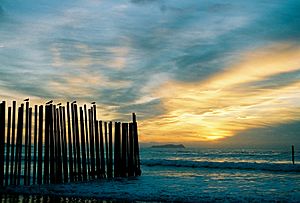
National protected areas
- Cabrillo National Monument
- Cleveland National Forest (part)
- San Diego National Wildlife Refuge Complex, which includes
There are 7 official wilderness areas in San Diego County that are part of the National Wilderness Preservation System. Four of these are integral parts of Cleveland National Forest, whereas three are managed by the Bureau of Land Management. Some of these extend into neighboring counties (as indicated below):
- Otay Mountain Wilderness (BLM)
- Pine Creek Wilderness (Cleveland National Forest)
- Hauser Wilderness (Cleveland National Forest)
- Carrizo Gorge Wilderness (BLM)
- Sawtooth Mountains Wilderness (BLM)
- Agua Tibia Wilderness (Cleveland National Forest) partly in Riverside County
- San Mateo Canyon Wilderness (Cleveland National Forest) mostly in Riverside County
State parks and protected areas
- Anza-Borrego Desert State Park (part)
- Torrey Pines State Reserve
- Cuyamaca Rancho State Park
- Palomar Mountain State Park
- San Pasqual Battlefield State Historic Park
- Old Town San Diego State Historic Park
- Border Field State Park
- Tijuana River Natural Estuarine Research Reserve
- San Onofre State Beach
- Moonlight State Beach
- Carlsbad State Beach
- South Carlsbad State Beach
- Leucadia State Beach
- San Elijo State Beach
- Cardiff State Beach
- Torrey Pines State Beach
- Silver Strand State Beach
Mountains
There are 236 mountain summits and peaks in San Diego County including:
- Black Mountain
- Cuyamaca Peak (second highest point in San Diego County)
- Cowles Mountain (highest point in the city of San Diego)
- Mount Helix
- Hot Springs Mountain (highest point in San Diego County)
- Margarita Peak
- Mount Soledad
- Stonewall Mountain
Bays and lagoons
Lakes
- Lake Cuyamaca
- Lake Hodges
- Santee Lakes
- Sweetwater Reservoir
- Otay Lakes
- Lake Wohlford
- El Capitan Reservoir
- Sutherland Reservoir
- Lake Henshaw
- Lake Murray
- San Vicente Reservoir
- Lake Jennings
- Barrett Reservoir
- Natural Rock Tanks
- Little Laguna Lake
- Big Laguna Lake
- Big Lake
- Twin Lakes
- Jean, Lake
- Lost Lake
- Swan Lake
- Lake Miramar
- Lake Poway
- Dixon Lake
Rivers
- San Diego River
- San Luis Rey River
- San Dieguito River
- Sweetwater River (California)
- Otay River
- Tijuana River
- Santa Margarita River
Demographics
In the 1847 census of San Diego County ordered by Richard Barnes Mason, it found that 2,287 people lived in the county, to include Native Americans, Pacific Islanders, and African Americans. Since at least 2014, San Diego County is the fifth most populous county in the United States. In 2000, only about 3% of San Diego County residents left the county for work while 40,000 people commuted into the metropolitan area.
| Historical population | |||
|---|---|---|---|
| Census | Pop. | %± | |
| 1850 | 798 | — | |
| 1860 | 4,324 | 441.9% | |
| 1870 | 4,951 | 14.5% | |
| 1880 | 8,018 | 61.9% | |
| 1890 | 34,987 | 336.4% | |
| 1900 | 35,090 | 0.3% | |
| 1910 | 61,665 | 75.7% | |
| 1920 | 112,248 | 82.0% | |
| 1930 | 209,659 | 86.8% | |
| 1940 | 289,348 | 38.0% | |
| 1950 | 556,808 | 92.4% | |
| 1960 | 1,033,011 | 85.5% | |
| 1970 | 1,357,854 | 31.4% | |
| 1980 | 1,861,846 | 37.1% | |
| 1990 | 2,498,016 | 34.2% | |
| 2000 | 2,813,833 | 12.6% | |
| 2010 | 3,095,313 | 10.0% | |
| 2020 | 3,298,634 | 6.6% | |
| 2023 (est.) | 3,269,973 | 5.6% | |
| U.S. Decennial Census 1790–1960 1900–1990 1990–2000 2010 2020 |
|||
2020 census
| Race / Ethnicity | Pop 2010 | Pop 2020 | % 2010 | % 2020 |
|---|---|---|---|---|
| White alone (NH) | 1,500,047 | 1,422,205 | 48.46% | 43.11% |
| Black or African American alone (NH) | 146,600 | 145,014 | 4.74% | 4.40% |
| Native American or Alaska Native alone (NH) | 14,098 | 12,841 | 0.46% | 0.39% |
| Asian alone (NH) | 328,058 | 400,589 | 10.60% | 12.14% |
| Pacific Islander alone (NH) | 13,504 | 12,991 | 0.44% | 0.39% |
| Some Other Race alone (NH) | 6,715 | 18,125 | 0.22% | 0.55% |
| Mixed Race/Multi-Racial (NH) | 94,943 | 167,240 | 3.07% | 5.07% |
| Hispanic or Latino (any race) | 991,348 | 1,119,629 | 32.03% | 33.94% |
| Total | 3,095,313 | 3,298,634 | 100.00% | 100.00% |
Note: the US Census treats Hispanic/Latino as an ethnic category. This table excludes Latinos from the racial categories and assigns them to a separate category. Hispanics/Latinos can be of any race.
Racial and Ethnic Composition since 1960
| Racial composition | 2020 | 2010 | 2000 | 1990 | 1980 | 1970 | 1960 |
|---|---|---|---|---|---|---|---|
| White (non-Hispanic) | 43.1% | 48.5% | 55.0% | 65.3% | 73.8% | – | – |
| Hispanic or Latino | 33.9% | 32.0% | 26.7% | 20.4% | 14.7% | 12.8% | – |
| Asian (non-Hispanic) | 12.1% | 10.6% | 8.8% | 7.9% | – | – | 1.1% |
| Black or African American (non-Hispanic) | 4.4% | 4.7% | 5.7% | 6.3% | 5.6% | 4.5% | 3.8% |
| Native American (non-Hispanic) | 0.4% | 0.5% | 0.8% | 0.8% | – | – | 0.3% |
| Pacific Islander (non-Hispanic) | 0.4% | 0.4% | 0.5% | – | – | – | – |
| Mixed Race (non-Hispanic) | 5.1% | 3.1% | 4.7% | – | – | – | – |
| Population, race, and income (2011) | |||||
|---|---|---|---|---|---|
| Total population | 3,060,849 | ||||
| White | 2,182,604 | 71.3% | |||
| Hispanic or Latino (of any race) | 967,858 | 31.6% | |||
| Asian | 333,314 | 10.9% | |||
| Black or African American | 154,076 | 5.0% | |||
| American Indian or Alaska Native | 20,597 | 0.7% | |||
| Native Hawaiian or other Pacific Islander | 14,266 | 0.5% | |||
| Some other race | 220,000 | 7.2% | |||
| Two or more races | 135,992 | 4.4% | |||
| Per capita income | $30,955 | ||||
| Median household income | $63,857 | ||||
| Median family income | $74,633 | ||||
| Historical population | |||
|---|---|---|---|
| Census | Pop. | %± | |
| 1850 | 798 | — | |
| 1860 | 4,324 | 441.9% | |
| 1870 | 4,951 | 14.5% | |
| 1880 | 8,018 | 61.9% | |
| 1890 | 34,987 | 336.4% | |
| 1900 | 35,090 | 0.3% | |
| 1910 | 61,665 | 75.7% | |
| 1920 | 112,248 | 82.0% | |
| 1930 | 209,659 | 86.8% | |
| 1940 | 289,348 | 38.0% | |
| 1950 | 556,808 | 92.4% | |
| 1960 | 1,033,011 | 85.5% | |
| 1970 | 1,357,854 | 31.4% | |
| 1980 | 1,861,846 | 37.1% | |
| 1990 | 2,498,016 | 34.2% | |
| 2000 | 2,813,833 | 12.6% | |
| 2010 | 3,095,313 | 10.0% | |
| 2020 | 3,298,634 | 6.6% | |
| U.S. Decennial Census 1790–1960 1900–1990 1990–2000 2010–2018 2020 census |
|||
Race
The 2010 United States census reported that San Diego County had a population of 3,095,313. The racial makeup of San Diego County was 1,981,442 (64.0%) White, 158,213 (5.1%) African American, 26,340 (0.9%) Native American, 336,091 (10.9%) Asian (4.7% Filipino, 1.6% Vietnamese, 1.4% Chinese, 3.2% Other Asian), 15,337 (0.5%) Pacific Islander, 419,465 (13.6%) from other races, and 158,425 (5.0%) from two or more races. Hispanic or Latino of any race were 991,348 people (32.0%). Including those of mixed race, the total number of residents with Asian ancestry was 407,984.
As of 2009, the racial makeup of the county was 79.4% White American, 5.6% Black or African American, 1% Native American, 10.4% Asian, 0.5% Pacific Islander, 10.3% from other races, and 3.6% from two or more races. 31.3% of the population were Hispanic or Latino of any race.
67.0% spoke only English at home; 21.9% spoke Spanish, 3.1% Tagalog and 1.2% Vietnamese.
Other demographic data
As of 2018, the Census Bureau estimates there were 3,343,364 people, 1,067,846 households, and 663,449 families residing in the county. The population density was 670 inhabitants per square mile (260/km2). There were 1,142,245 housing units at an average density of 248 per square mile (96/km2).
In 2000, there were 994,677 households, out of which 33.9% had children under the age of 18 living with them, 50.7% were married couples living together, 11.6% had a female householder with no husband present, and 33.3% were non-families. 24.2% of all households were made up of individuals, and 7.9% had someone living alone who was 65 years of age or older. The average household size was 2.73 and the average family size was 3.29.
As of 2000, 25.7% of the population was under the age of 18, 11.30% was from 18 to 24, 32.0% from 25 to 44, 19.8% from 45 to 64, and 11.2% was 65 years of age or older. The median age was 33 years. For every 100 females, there were 101.2 males. For every 100 females age 18 and over, there were 99.7 males.
In 2012, it was estimated that there were 198,000 unauthorized immigrants; the origin of the plurality of them is Mexico.
In 2018, the median household income was $70,824; most people spend more than 30% of their income on housing costs. In August of that year, the median home price was $583,000; this is lower than the median home price in Los Angeles, and Orange counties.
Income
According to the 2000 census, the median income for a household in the county was $47,067, and the median income for a family was $53,438. Males had a median income of $36,952 versus $30,356 for females. The per capita income for the county was $22,926. About 8.9% of families and 12.4% of the population were below the poverty line, including 16.5% of those under age 18 and 6.8% of those age 65 or over.
Much of the county's high-income residents are concentrated in the northern part of the city of San Diego. The San Diego metropolitan area has two places with both a population of over 50,000 and a per capita income of over $40,000: Carlsbad and Encinitas.
The county's largest continuous high-income urban area is a triangle from a first point on the northern edge of Carlsbad, a second point southeast of Escondido, and a third point on the southern edge of La Jolla. It contains all or most of the cities of Carlsbad, Encinitas, Solana Beach, Del Mar, and Poway in addition to a substantial portion of northern San Diego.
Homelessness
According to a Point-In-Time count taken for the San Diego Regional Task Force on the Homeless, there were 8,576 homeless individuals on January 6, 2018, a 6% decrease from 2017. 3,586 were sheltered, and 4,990 were not. 4,912 (75.3%) were in the City of San Diego. North County Inland had 1,153 (13.4%), North County Coastal with 822 homeless (9.6%), 602 (7%) were found in South County, and 1,087 (12.7%) in East County.
Religion
According to the Pew Research Center as of 2014[update], 68% of adults in the county are Christian, of whom 32% are Catholic. 27% were unaffiliated, and 5% adhered to a Non-Christian faith. According to the University of Southern California, in 2010, the largest faith in the county was Catholicism, followed by Nondenominational Christians, and Mormons.
In 2014, the county had 978 religious organizations, the seventh most out of all US counties.
Immigration data
In 2014 according to Pew Research Center, there are about 170,000 undocumented immigrants living in the region. ..... In 2018, the United States Border Patrol caught an average of over a hundred individuals crossing the border illegally each day.
Economy
San Diego County and Imperial County are part of the Southern Border Region, one of nine such regions. As a regional economy, the Southern Border Region is the smallest but most economically diverse region in the state. However, the two counties maintain weak relations and have little in common aside from their common border. The region has a high cost of living. This includes the highest cost of water in the United States. As of 2018[update], San Diego County is within the top ten highest cost of rent in the United States; this has led to people moving out of the county.
Agriculture
San Diego County's agriculture industry was worth $1.85 billion in 2013, and is one of the top five egg producing counties in the United States. In 2013, San Diego County also had the most small farms of any county in the United States, and had the 19th largest agricultural economy of any county in the United States. According to the San Diego Farm Bureau, San Diego County is the United States' leading producer of avocados and nursery crops. Until the early 20th century, San Diego County had a thriving wine industry; however the 1916 Charles Hatfield flood was the beginning of the end of the industry which included the destruction of the Daneri winery in Otay Valley. As of October 2016[update], there are roughly one hundred vineyards and wineries in San Diego County.
By the 2019–2020 statistical survey, California Department of Food & Agriculture (cdfa) found that the nursery trade dominated the county's agriculture by dollar value. Second place went to avocado production.
Breweries
The county has been called "the Craft Beer Capital of America". Brewing has been one of the fastest-growing business sectors with local breweries ranking among the 50 largest craft brewers in the United States and breweries that are consistently rated among the top breweries in the world.
Tourism
Tourism plays a large part in the economics of the San Diego metropolitan area. Tourists are drawn to the region for a well rounded experience, everything from shopping to surfing as well as its mild climate. Its numerous tourist destinations include Westfield UTC, Seaport Village, and Fashion Valley for shopping. SeaWorld San Diego and Legoland California as amusement parks. Golf courses such as Torrey Pines Golf Course and Balboa Park Golf Course. Museums such as the Museum of Us, the San Diego Museum of Art, Fleet Science Center, San Diego Natural History Museum, USS Midway Museum, and the San Diego Air & Space Museum. Historical places such as the Gaslamp Quarter, Balboa Park and Old Town San Diego State Historic Park. Wildlife refuges, zoos, and aquariums such as the San Diego Zoo, San Diego Zoo Safari Park, Birch Aquarium, and the San Diego-La Jolla Underwater Park. Outdoor destinations include the Peninsular Ranges for hiking, biking, mountainboarding and trail riding. Surfing locations include Swami's, Stone Steps Beach, Torrey Pines State Beach, Cardiff State Beach, San Onofre State Beach and the southern portion of Black's Beach.
The region is host to the second largest cruise ship industry in California which generates an estimated $2 million annually from purchases of food, fuel, supplies, and maintenance services. In 2008, the Port of San Diego hosted 252 ship calls and more than 800,000 passengers.
Culture
The culture of San Diego is influenced heavily by American and Mexican cultures due to its position as a border town, its large Hispanic population, and its history as part of Spanish America and Mexico. The area's longtime association with the U.S. military also contributes to its culture. Present-day culture includes many historical and tourist attractions, a thriving musical and theatrical scene, numerous notable special events, a varied cuisine, and a reputation as one of America's premier centers of craft brewing.
Sites of interest
- Mount Laguna Observatory, owned and primarily operated by San Diego State University
- Palomar Observatory, owned and primarily operated by the California Institute of Technology
- Ramona Valley, a wine-producing region located 28 miles (45 km) northeast of the city of San Diego
- San Diego Zoo Safari Park, formerly known as the San Diego Wild Animal Park, 35 miles (56 km) north of the San Diego Zoo and east of Escondido
- SeaWorld San Diego on Mission Bay.
- Mission Bay Park, including Fiesta Island, a sheltered bay popular for water sports, also known for the annual over-the-line tournament.
- Mission San Diego de Alcalá, the first of California's 21 Spanish missions. It is an operating Roman Catholic parish and also is open for historical interest tours during the week. It is located near the interchange of Interstates 8 and 15.
- Mission San Luis Rey de Francia, founded on June 13, 1798, by Padre Fermín Lasuén. It is the 18th of the Spanish missions established in California. It is an operating Roman Catholic parish and is open every day for historical interest tours. It is located near Route 76 in the Oceanside area.
- Balboa Park, with numerous museums and other cultural locations, just north of Downtown San Diego.
- San Diego Zoo, located in Balboa Park
- Presidio Park, located on a bluff directly above Old Town, a city historic park on the site of the San Diego Presidio, the first European settlement in California.
- San Diego Bay contains the aircraft carrier USS Midway now used as a memorial ship and as a floating museum, and the eight floating museum ships of the Maritime Museum of San Diego. Harbor cruises, sailing, and sport fishing are also available
- San Diego Botanic Garden, a 37-acre botanic oasis in the coastal community of Encinitas. Features 4 miles of meandering trails, 5,300+ plant species and 29 uniquely themed gardens, including the largest public bamboo collection in North America.
- Legoland California, a Lego theme park in Carlsbad
- Sesame Place San Diego, a Sesame Street theme park in Chula Vista
- Alta Vista Botanical Gardens is a botanical garden in Vista dedicated to bringing together 'People, Nature & Art'.
- Mount Ecclesia is a historic district noted for its singular architecture and the preservation of nature grounds and gardens, offering a unique meditative walking experience. It is located about a mile east of Interstate 5 in the Oceanside area.
- San Dieguito County Park
Sports
Sports in San Diego County includes major professional league teams, other highest-level professional league teams, minor league teams, and college athletics. San Diego County hosts two teams of the major professional leagues, the San Diego Padres of Major League Baseball (MLB) and San Diego FC of Major League Soccer (MLS). The county is home to several universities whose teams compete in various NCAA Division I sports, most notably the San Diego State Aztecs. The Farmers Insurance Open, a professional golf tournament on the PGA Tour, is played annually at Torrey Pines Golf Course.
San Diego County hosted the National Football League (NFL)'s San Diego Chargers from 1961 to 2017, when the team relocated to the Greater Los Angeles area (now the Los Angeles Chargers). The county also hosted the National Basketball Association (NBA)'s San Diego Rockets from 1967 to 1971 (now the Houston Rockets) and San Diego Clippers from 1978 to 1984 (now the Los Angeles Clippers). San Diego County has never hosted a National Hockey League (NHL) franchise, though it hosted the San Diego Mariners of the now-defunct World Hockey Association (WHA) from 1974 to 1977.
Currently, there is no NFL, NBA, or NHL team in the county. San Diego is the largest American city not to have won a championship in a "Big Four" major professional league. The city does have one major league title to its name: the 1963 American Football League (AFL) Championship won by the San Diego Chargers, when the AFL was an independent entity prior to the AFL–NFL merger in 1970. Due to its lackluster record on winning professional championships, and in some cases retaining professional teams, some San Diego sports fans believe there is a curse on professional sports in the city.
Education
San Diego County contains three public state universities: University of California, San Diego (UC San Diego); San Diego State University (SDSU); and California State University, San Marcos (CSUSM). Major private universities in the county include University of San Diego (USD), Point Loma Nazarene University (PLNU), Alliant International University (AIU), and National University. It also includes three law schools, the USD School of Law, California Western School of Law, and the Thomas Jefferson School of Law.
Within the county there are 24 public elementary school districts, 6 high school districts, and 12 unified school districts. There are also five community college districts.
Several cities in the county maintain public library systems, including the city of San Diego itself. The San Diego County Library serves all other areas of the county. In 2010 the county library had 33 branches and two bookmobiles; circulated over 10.7 million books, CDs, DVDs, and other material formats; recorded 5.7 million visits to library branches; and hosted 21,132 free programs and events. The San Diego County Library is one of the 25 busiest libraries in the nation as measured by materials circulated.
Community College Districts
- Grossmont–Cuyamaca Community College District
- MiraCosta Community College District
- Palomar Community College District
- San Diego Community College District
- Southwestern Community College District
K-12 schools
- School districts
K-12 unified:
- Borrego Springs Unified School District
- Bonsall Unified School District
- Carlsbad Unified School District
- Coronado Unified School District
- Mountain Empire Unified School District
- Oceanside Unified School District
- Poway Unified School District
- Ramona Unified School District
- San Diego Unified School District
- San Marcos Unified School District
- Vista Unified School District
- Valley Center-Pauma Unified School District
- Warner Unified School District
Secondary:
- Escondido Union High School District
- Fallbrook Union High School District
- Grossmont Union High School District
- Julian Union High School District
- San Dieguito Union High School District
- Sweetwater Union High School District
Elementary:
- Alpine Union Elementary School District
- Cajon Valley Union Elementary School District
- Cardiff Elementary School District
- Chula Vista Elementary School District
- Dehesa Elementary School District
- Del Mar Union Elementary School District
- Encinitas Union Elementary School District
- Escondido Union Elementary School District
- Fallbrook Union Elementary School District
- Jamul-Dulzura Union Elementary School District
- Julian Union Elementary School District
- La Mesa-Spring Valley School District
- Lakeside Union Elementary School District
- Lemon Grove Elementary School District
- National Elementary School District
- Rancho Santa Fe Elementary School District
- San Pasqual Union Elementary School District
- San Ysidro Elementary School District
- Santee School District
- Solana Beach Elementary School District
- South Bay Union School District
- Spencer Valley Elementary School District
- Vallecitos Elementary School District
Military
San Diego is the headquarters of the U.S. Navy's Eleventh Naval District and is the Navy's principal location for West Coast and Pacific Ocean operations. Naval Base San Diego, California is principal home to the Pacific Fleet (although the headquarters is located in Pearl Harbor). NAS North Island is located on the north side of Coronado, and is home to Headquarters for Naval Air Forces and Naval Air Force Pacific, the bulk of the Pacific Fleet's helicopter squadrons, and part of the West Coast aircraft carrier fleet.
The Naval Special Warfare Center is the primary training center for SEALs, and is also located on Coronado. The area contains five major naval bases and the U.S. Marines base Camp Pendleton. Marine Corps Base Camp Pendleton is the major West Coast base of the United States Marine Corps and serves as its prime amphibious training base. It is located on the Southern California coast, bordered by Oceanside to the south, San Clemente to the north, and Fallbrook to the east.
- Naval Base San Diego, also known as 32nd Street Naval Station
- Naval Amphibious Base Coronado
- Naval Air Station North Island
- Naval Base Point Loma, which includes the Submarine Base and the Fleet Antisubmarine Warfare Training Center
- Space and Naval Warfare Systems Command (SPAWAR)
- Naval Medical Center San Diego, also known as Bob Wilson Naval Hospital and Balboa Naval Hospital
U.S. Marine Corps
- Marine Corps Base Camp Pendleton
- Marine Corps Air Station Miramar
- Marine Corps Recruit Depot San Diego
U.S. Coast Guard
- Coast Guard Air Station San Diego
Media
San Diego County is primarily served by media in San Diego, including TV and radio stations based in the city.
Newspapers
San Diego County is served by many newspapers. The major regional paper is The San Diego Union-Tribune, also known as U-T San Diego or just "The U-T" by locals, is ranked 23rd in the country (by daily circulation) as of March 2013. The Union-Tribune serves both San Diego County and neighboring Imperial County. The former North County Times, based in Escondido and serving portions of Riverside County and North County, was purchased by the Union-Tribune in 2012 and closed down. For about a year after absorbing the North County Times the Union-Tribune published a North County edition, but the regional edition was later abandoned. The Los Angeles Times is also delivered in portions of the county. Many of the area's cities, towns and neighborhoods have their own local newspapers; the Union Tribune bought eight local weeklies in 2013 and is continuing to publish them as independent local newspapers. The San Diego Daily Transcript reports business and legal news. Privately published papers like the Military Press Newspaper and the Navy Dispatch serve the military community both on and off base.
Other media
County Television Network is a public-access television cable channel, offering a "hometown blend of C-SPAN, the Lifetime, History, Travel, and Discovery channels" for the county, and funded by fees paid by cable companies.
Transportation
Major highways
 Interstate 5
Interstate 5 Interstate 8
Interstate 8 Interstate 15
Interstate 15 Interstate 805
Interstate 805 U.S. Route 80 (decommissioned)
U.S. Route 80 (decommissioned) U.S. Route 101 (decommissioned)
U.S. Route 101 (decommissioned) State Route 11
State Route 11 State Route 15
State Route 15 State Route 52
State Route 52 State Route 54
State Route 54 State Route 56
State Route 56 State Route 67
State Route 67 State Route 75
State Route 75 State Route 76
State Route 76 State Route 78
State Route 78 State Route 79
State Route 79 State Route 94
State Route 94 State Route 125
State Route 125 State Route 163
State Route 163 State Route 188
State Route 188 State Route 282
State Route 282 State Route 905
State Route 905
Border crossings to Mexico
- San Ysidro Port of Entry
- Otay Mesa Port of Entry
- Otay Mesa East Port of Entry (projected opening 2028)
- Tecate Port of Entry
Railroads
- (Amtrak) Pacific Surfliner
- Coaster
- Metrolink
- San Diego and Arizona Eastern Railway
- San Diego and Imperial Valley Railroad
Light rail and local transit
- San Diego Trolley
- San Diego Metropolitan Transit System (MTS)
- Sprinter
- North County Transit District (NCTD)
The Port of San Diego
- Embarcadero
Airports
Carlsbad
- McClellan–Palomar Airport (CRQ)
El Cajon
- Gillespie Field (SEE)
Oceanside
City of San Diego
- San Diego International Airport (SAN)
- Montgomery-Gibbs Executive Airport (MYF)
- Brown Field Municipal Airport (SDM)
Unincorporated San Diego County
- Agua Caliente Airport (L54)
- Borrego Valley Airport (L08)
- Fallbrook Community Airpark (L18)
- Jacumba Airport (L78)
- Ocotillo Airport (L90)
- Ramona Airport (RNM)
Communities
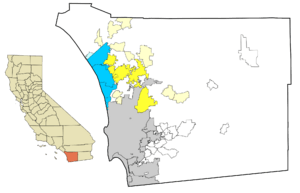
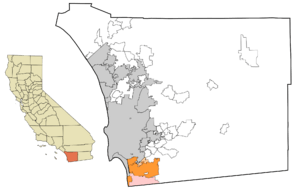
Cities
| City | Population |
|---|---|
| San Diego |
1,307,402
|
| Chula Vista |
243,916
|
| Oceanside |
183,095
|
| Escondido |
143,911
|
| Carlsbad |
105,328
|
| El Cajon |
99,478
|
| Vista |
93,834
|
| San Marcos |
83,781
|
| Encinitas |
59,518
|
| National City |
58,582
|
| La Mesa |
57,065
|
Census-designated places
- Alpine
- Bonita
- Bonsall
- Borrego Springs
- Bostonia
- Boulevard
- Campo
- Camp Pendleton North
- Camp Pendleton South
- Casa de Oro-Mount Helix
- Crest
- Descanso
- Eucalyptus Hills
- Fairbanks Ranch
- Fallbrook
- Granite Hills
- Harbison Canyon
- Hidden Meadows
- Jacumba Hot Springs
- Jamul
- Julian
- Lake San Marcos
- Lakeside
- La Presa
- Mount Laguna
- Pine Valley
- Potrero
- Rainbow
- Ramona
- Rancho San Diego
- Rancho Santa Fe
- San Diego Country Estates
- Spring Valley
- Valley Center
- Winter Gardens
Unincorporated communities
- 4S Ranch
- Ballena
- Barrett Junction
- Blossom Valley
- Canebrake
- Cardiff-by-the-Sea
- Dehesa
- Del Dios
- De Luz
- Dulzura
- Elfin Forest
- Fernbrook
- Flinn Springs
- Four Corners
- Guatay
- Harmony Grove
- Kentwood-In-The-Pines
- Leucadia
- Lincoln Acres
- Live Oak Springs
- Oak Grove
- Ocotillo Wells
- Olivenhain
- Pala
- Pauma Valley
- Pine Hills
- Ranchita
- Rincon
- San Luis Rey
- Santaluz
- Santa Ysabel
- Shelter Valley
- Tecate
- Tierra del Sol
- Warner Springs
- Whispering Pines
- Wynola
Indian reservations
San Diego County has 18 federally recognized Indian reservations, more than any other county in the United States. Although they are typical in size to other Indian reservations in California (many of which are termed "Rancherías"), they are relatively tiny by national standards, and all together total 200.2 square miles (518.5 km²) of area.
- Barona Indian Reservation
- Campo Indian Reservation
- Capitan Grande Reservation
- Ewiiaapaayp Indian Reservation
- Inaja and Cosmit Indian Reservation
- Jamul Indian Village
- La Jolla Indian Reservation
- La Posta Indian Reservation
- Los Coyotes Indian Reservation
- Manzanita Indian Reservation
- Mesa Grande Indian Reservation
- Pala Indian Reservation
- Pauma and Yuima Indian Reservation
- Rincon Indian Reservation
- San Pasqual Indian Reservation
- Santa Ysabel Indian Reservation
- Sycuan Indian Reservation
- Viejas Indian Reservation
Population ranking
The population ranking of the following table is based on the 2010 census of San Diego County.
† county seat
| Rank | City/Town/etc. | Municipal type | Population (2010 Census) |
|---|---|---|---|
| 1 | † San Diego | City | 1,307,402 |
| 2 | Chula Vista | City | 243,916 |
| 3 | Oceanside | City | 167,086 |
| 4 | Escondido | City | 143,911 |
| 5 | Carlsbad | City | 105,328 |
| 6 | El Cajon | City | 99,478 |
| 7 | Vista | City | 93,834 |
| 8 | San Marcos | City | 83,781 |
| 9 | Encinitas | City | 59,518 |
| 10 | National City | City | 58,582 |
| 11 | La Mesa | City | 57,065 |
| 12 | Santee | City | 53,413 |
| 13 | Poway | City | 47,811 |
| 14 | La Presa | CDP | 34,169 |
| 15 | Fallbrook | CDP | 30,534 |
| 16 | Spring Valley | CDP | 28,205 |
| 17 | Imperial Beach | City | 26,324 |
| 18 | Lemon Grove | City | 25,320 |
| 19 | Rancho San Diego | CDP | 21,208 |
| 20 | Lakeside | CDP | 20,648 |
| 21 | Winter Gardens | CDP | 20,631 |
| 22 | Ramona | CDP | 20,292 |
| 23 | Coronado | City | 18,912 |
| 24 | Casa de Oro-Mount Helix | CDP | 18,762 |
| 25 | Bostonia | CDP | 15,379 |
| 26 | Alpine | CDP | 14,236 |
| 27 | Solana Beach | City | 12,867 |
| 28 | Bonita | CDP | 12,538 |
| 29 | Camp Pendleton South | CDP | 10,616 |
| 30 | San Diego Country Estates | CDP | 10,109 |
| 31 | Valley Center | CDP | 9,277 |
| 32 | Jamul | CDP | 6,163 |
| 33 | Eucalyptus Hills | CDP | 5,313 |
| 34 | Camp Pendleton North | CDP | 5,200 |
| 35 | Lake San Marcos | CDP | 4,437 |
| 36 | Del Mar | City | 4,161 |
| 37 | Bonsall | CDP | 3,982 |
| 38 | Harbison Canyon | CDP | 3,841 |
| 39 | Hidden Meadows | CDP | 3,485 |
| 40 | Borrego Springs | CDP | 3,429 |
| 41 | Fairbanks Ranch | CDP | 3,148 |
| 42 | Rancho Santa Fe | CDP | 3,117 |
| 43 | Granite Hills | CDP | 3,035 |
| 44 | Campo | CDP | 2,684 |
| 45 | Crest | CDP | 2,593 |
| 46 | Rainbow | CDP | 1,832 |
| 47 | Pine Valley | CDP | 1,510 |
| 48 | Julian | CDP | 1,502 |
| 49 | Descanso | CDP | 1,423 |
| 50 | Pala Indian Reservation | AIAN | 1,315 |
| 51 | Rincon Reservation | AIAN | 1,215 |
| 52 | San Pasqual Reservation | AIAN | 1,097 |
| 53 | Potrero | CDP | 656 |
| 54 | Barona Reservation | AIAN | 640 |
| 55 | Jucumba Hot Springs | CDP | 561 |
| 56 | Viejas Reservation | AIAN | 520 |
| 57 | La Jolla Reservation | AIAN | 476 |
| 58 | Campo Indian Reservation | AIAN | 362 |
| 59 | Santa Ysabel Reservation | AIAN | 330 |
| 60 | Boulevard | CDP | 315 |
| 61 | Sycuan Reservation | AIAN | 211 |
| 62 | Pauma and Yuima Reservation | AIAN | 206 |
| t-63 | Los Coyotes Reservation | AIAN | 98 |
| t-63 | Mesa Grande Reservation | AIAN | 98 |
| 64 | Manzanita Reservation | AIAN | 78 |
| 65 | Mount Laguna | CDP | 57 |
| 66 | La Posta Indian Reservation | AIAN | 55 |
See also
 In Spanish: Condado de San Diego para niños
In Spanish: Condado de San Diego para niños


